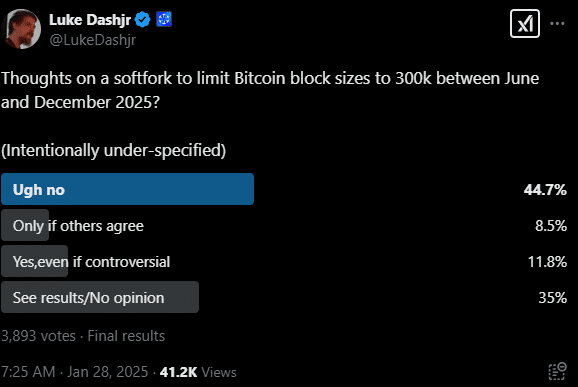-
Bitcoin’s scalability is poised for a transformative leap, with projections suggesting a potential 4 MB block size by late 2026.
-
Analysts from Mempool attribute this anticipated growth to an increase in inscription usage, showcasing a shift in Bitcoin’s utility beyond mere transactions.
-
Mempool’s report emphasizes, “If we see massive growth in the use of Bitcoin to store arbitrary data… the blockchain would reach 1TB by late 2026.”
This article explores Bitcoin’s projected block size growth to 4 MB by 2026, driven by increased inscription usage and its implications for scalability.
Expanding Bitcoin’s Block Size: A New Era of Scalability
The Bitcoin network, known for its decentralization and security, could see its block size expand significantly in the coming years. Current estimates suggest a surge in size to approximately 4 MB by late 2026, largely driven by increased demand for inscription protocols that utilize the blockchain for diverse data storage.
This anticipated growth is not just a number; it signifies a paradigm shift in how Bitcoin can be utilized, potentially redefining its position in the cryptocurrency market. The implications of such expansion could alter transaction processing capabilities, enabling more data to be handled per block.
Understanding the Rise of Inscriptions
The evolution of the Bitcoin network post-SegWit has resulted in higher utilization. The initial cap of 1 MB has been routinely tested, with many miners pushing for larger blocks to accommodate the surge in inscription activity. According to Mempool’s findings, as the average block size increases, it indicates a robust demand for transaction data.
The report states, “The median block size increased until block 400,000…Following SegWit’s introduction, block size gradually increased.” This enhanced capacity has allowed innovative uses of Bitcoin beyond currency, such as smart contracts and other decentralized applications.
The Controversial Debate on Block Size Limits
Despite the optimistic projections, there is a palpable divide within the Bitcoin development community regarding the expansion of block sizes. Notable Bitcoin core developer Luke Dash Jr has voiced concerns, perceiving the increasing use of ordinals and inscriptions as detrimental, characterizing them as ‘spam’ that could compromise the network’s integrity.
Dash’s camp advocates for limiting block sizes to mitigate perceived threats, proposing a cap below 1 MB. However, this view has not garnered widespread support among users and developers who favor a more accommodating approach to accommodate growing transaction needs.

Comparative Scalability: Bitcoin versus Solana
In contrast to Bitcoin, which is grappling with block size controversies, other networks like Solana exhibit the capacity for expansive throughput. With a theoretical block size limit of 128 MB, Solana can facilitate a broader array of applications at significantly higher speeds.
However, these advantages come at the cost of decentralization, a principle Bitcoin staunchly protects. As Bitcoin continues to navigate its block size debate, understanding these comparative dynamics is critical for assessing its future scalability and adoption in a rapidly evolving digital landscape.
Conclusion
As we look towards late 2026, Bitcoin’s potential block size growth to 4 MB represents a pivotal point for its scalability. While the demand for efficient data storage drives this transformation, the varied opinions within the development community highlight the complexities facing Bitcoin’s future.
The outcome of this discourse will significantly shape how Bitcoin adapts and maintains its relevance in an increasingly competitive blockchain environment. Continuous observation will be essential as these developments unfold.
